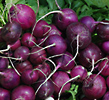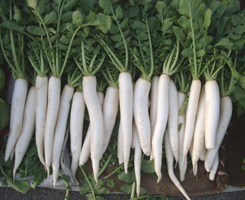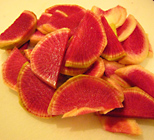HEALTH BENEFITS OF RADISH
THE INFORMATION COMPILED IS FROM NET. Radishes come in different forms varying in size, color and duration of required cultivation time. They can be broadly categorized into four main types-summers, fall, winter, and spring while growers classify them by shapes, colors, and sizes, such as black or white colored, with round or elongated roots. Their biting pungent flavor comes from "isothiocyanate" compound in them, which ranges from mild in case of white-icicles to be very hot in red globe and other pigmented radishes. The top greens are also eaten as leafy-vegetables in some parts of the world. Daikon or Japanese radishes are native to Asia. They are generally grown during winter months and have elongated smooth, icy-white roots.
Green radish is native to Northern China region. Its outer peel near the top stem end features leafy-green color which, gradually changes to white color near the lower tip. Inside, its flesh has beautiful jade green color, sweet and less pungent flavor. Watermelon radishes have watermelon like flesh inside. However, they taste sweet and less peppery, something similar to that of white varieties. When left to grow for longer than the usual root harvest period, all radish varieties bear small flowers, which subsequently develop into edible fruit pods. Podding or a rat-tailed radish is a type of seed pod variety grown exclusively for their long rat-tail like tapering pods. The pods feature mild radish-like flavor and spiciness. Om namo narayanaya Health benefits of radish
In general, radishes are available year-around with peak season during winter and spring. Daikons are most flavorful and juicy during winter.
Look for roots that feature fresh, stout and firm in texture. Their top greens also should be fresh, and feature crispy green without any yellow, shriveled leaves. Avoid roots that have cracks or cuts on their surface. Look carefully for the change in their texture and color. Yellowness indicated the stock is old. If the root yields to pressure and soft, the interior likely be pithy instead of crispy.
Once at home, remove the top greens as they rob nutrients of the roots. Then wash thoroughly in clean water to rid off surface dust and soil. Store them in a zip pouch or plastic bag in the refrigerator where they remain fresh for up to a week.
Preparation and serving methodsBoth root and top greens are used for cooking. Peeling may be avoided as the anti-oxidant allyl-isothiocyanates, which gives a peppery pungent flavor to radish, are thickly concentrated in the peel. Just wash the root thoroughly, trim the tip ends, and if you have to peel, then gently pare away superficial thin layer only.Here are some serving tips:
Safety profileRadishes may contain goitrogens, plant-based compounds found in cruciferous and Brassica family vegetables like cauliflower, broccoli, etc. Goitrogens may cause swelling of thyroid gland and should be avoided in individuals with thyroid dysfunction. However, they may be used liberally in healthy persons. (Medical disclaimer). |
Saturday, 22 June 2013
HEALTH BENEFITS OF RADISH
Subscribe to:
Post Comments (Atom)





Thanks for sharing such beautiful information with us. I hope you will share some more information about radish. Please keep sharing. Daikon Radish Leaves Benefits For Health
ReplyDeletethanks for visiting the blog
Delete